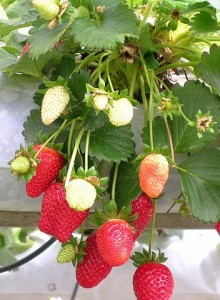
More evidence that low-calorie sweeteners are bad for your health
Studies show that artificial sweeteners can raise the risk of hypertension, metabolic syndrome, type 2 diabetes and heart disease, including stroke.

Natural Health News — Strawberries are the quintessential summer fruit and it may not be long, say researchers, before we could be enjoying wearing them as much as we enjoy eating them.
That’s because a collaboration of Spanish and Italian scientist have found that chemicals in strawberries can help protect the skin from the harmful effects of the sun.
In a laboratory study published in the Journal of Agricultural Food Chemistry, the researchers prepared human skin cell cultures (fibroblasts) and added strawberry extract in different concentrations (0.05, 0.25 and 0.5 mg/ml). The skin cells were also treated with an inactive control substance. Using ultraviolet light, the samples were then exposed to a dose “equivalent to 90 minutes of midday summer sun in the French Riviera.”
The strawberry extract, especially at the highest concentration, was not only photoprotective against skin ageing UVA rays, it also increased cell survival and viability and decreased DNA damage when compared to the inactive control substance.
Powerful pigments
The scientists suggest that anthocyanins, pigments that give leaves, flowers and fruits their red colour, could be responsible for the protective effect.
“These compounds have important anti-inflammatory, antioxidant and anti-tumour properties and are capable of modulating enzymatic processes,” explains one of the authors, Sara Tulipani from the University of Barcelona. thought she adds that they do not yet fully understand how anthocyanins might work to protect against UVA.
Most suncreams are little more than chemical cocktails chemicals. They may block the sun’s rays but they do little to improve the overall health of your skin and increasingly there are question marks over the safety of the chemicals used in them.
In search of natural alternatives
Suncreams have long been problematical both for consumers and for companies that manufacture them.
Sunscreening chemicals such as the benzophenones and cinnamates as well as padimate-O give good coverage in relatively light emulsions, but research has shown them to have an estrogenic effect.. This is why many manufacturers have reformulated, turning instead to mineral sunscreens like micronised zinc oxide. While micronised zinc oxide can provide good protection without leaving a white residue, some manufacturers have complicated the picture further for consumers by choosing to formulate with nano zinc oxide – the safety of which is still not certain.
While we are still some way off having a new novel sunscreening ingredient made from strawberries, this study provides hope that the option of a plant-based sunscreen that not only protects the skin from UV rays but also helps repair sun damage is coming.
Beyond strawberries
Strawberries aren’t the only natural substance under investigation for photo protective qualities.
In an recent review in the journal Alternative and Complimentary Therapies entitled “Herbal Sunscreens and Ultraviolet Protectants” researchers specifically identify golden serpent fern (Phlebodium aureum or Polypodium leucatomos) and Asian ginseng (Panax ginseng) as herbal products that, when taken orally, may reduce the local and systemic negative effects of UV light exposure, including photoaging, increased risk of skin cancer, and harm done to immune system function.
Sufficiently high oral doses or topical application of green tea (Camellia sinensis), say the reviewers, may also offer photoprotection.

Please subscribe me to your newsletter mailing list. I have read the
privacy statement